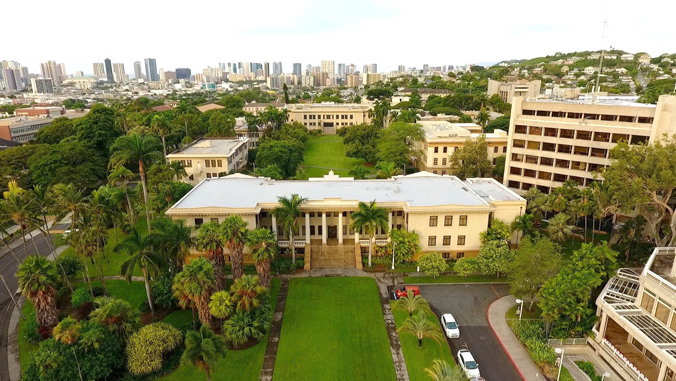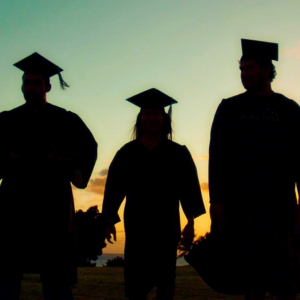
Update September 14: This message was shared with the students of the University of Hawaiʻi at Mānoa on September 12, 2020. The message to faculty and staff on September 11 follows the student message.
Aloha students,
I hope you are settling into your classes. This semester, of course, is different from what many of us originally planned as the state continues to work to bring the COVID-19 infection rate down and stop the spread of the disease. Thank you for the safety precautions you are taking to protect your health and the health of those around you.
A significant long term effect of the pandemic will be an economic downturn, especially here in a state that relies heavily on tourism. The UH Board of Regents has asked UH Mānoa to start preparing for the short and long term of this financial crisis. To that end, administrators and faculty are discussing the role of our university in rebuilding the economy, as well as how we can best meet our educational, research and service mission. I sent a message to the faculty on this topic with more information, resources and the data being used to help guide our planning. (Editor’s note: Employee message follows the student message.)
Over the course of the semester, you are likely to hear debates about the future of some of our degree programs, and about how departments or schools and colleges might be reorganized in order to be stronger, more effective and cut costs.
Although it is urgent that we respond to the economic crisis, long- term changes to the university do take time. No student should be concerned that their degree program will disappear. Even when our university makes the difficult decision to end a degree program, all of the students enrolled in that program must graduate before it is terminated. Ending a degree program also does not mean that we stop teaching that area. Courses, especially those at the lower division or that fulfill our General Education requirements, typically continue.
You have chosen to pursue your studies here with us, and it is my pledge to you that as we work to ensure a vibrant future for UH Manoa, we will engage you, our students, in that important work.
E malama pono,
Michael Bruno
UH Mānoa Provost
The following message was shared with the faculty and staff of the University of Hawaiʻi at Mānoa on September 11, 2020.
Aloha colleagues,
The University of Hawaiʻi at Mānoa is the flagship campus of the UH System, and one of the nation’s premier public R1 research universities. Located in the most diverse community and environment in the world, the university is a globally recognized center of learning and research with a kuleana to serve the people and places of Hawaiʻi, and our neighbors in the Pacific and Asia. As a land-, sea-, space- and sun-grant university, UH Mānoa has unique responsibilities and opportunities to deliver applied research and education programs that are relevant to the pressing needs of Hawaiʻi and beyond.
The COVID-19 pandemic has now confronted the State and UH with the most dire fiscal crisis in our history. We should have no pretense that routine evolutionary change will enable us to help the state recover and flourish under the financial condition we face today and for a number of years to come. Although the precise extent and nature of the cuts to our State allocation remain unclear, it is certain that these cuts will be significantly larger than those we experienced during the Great Recession. As described in the presentation to the Board of Regents by UHERO Executive Director Carl Bonham, we should expect that the impact to the State economy as a result of the pandemic will persist for at least 5 years.

We serve the public good, and as such, we must be exemplary stewards of taxpayers’ and donors’ resources while staying true to our mission. In a real sense, our “value” is measured by the quality and impact of our student learning, our scholarship and our service in the community. We serve Hawaiʻi best when our graduates succeed and advance our people, when our scholarship addresses critical challenges and opportunities, and when our service advances the communities in which we are embedded. And when we are successful in these aspects of our work together, we generate increased tuition revenue, external research funding, philanthropy and greater support from the people and institutions of Hawaiʻi.
As described in the UH Mānoa budget narrative presented to the Board of Regents on September 3, our response to this crisis involves two stages, with the first beginning last March as we began to conserve resources during the closing months of fiscal year 2020 through a strict hiring freeze and a restriction on other spending in order to produce budget savings to help us through the present fiscal year, FY21. We have also announced the decision that executive and managerial personnel will not benefit from the negotiated salary increase that our faculty and staff will receive in FY21.
The second stage embraces the recognition that we need to go beyond these painful and non-strategic expenditure reduction tactics in order to re-make the university to be more efficient, more effective, and more directly focused on the needs of Hawaiʻi today. It is intended to support a transformation that takes place in FY22 and beyond, beginning in July 2021. We began a process in April to challenge the UH Mānoa units to develop plans to produce significant cost savings (scenarios included 5 percent, 10 percent, and 15 percent cost savings) via a variety of means such as the reduction of administrative costs, the elimination of low enrollment academic programs and the reorganization of programs and departments with the aim of producing new or enhanced opportunities for program and revenue growth. It is important to note that this effort did not focus only on the academic units. Rather, we examined all of the vice chancellor-level units (academic and student affairs, enrollment management and research) as well as athletics, facilities and information technology services. I have also participated with my fellow officers of the UH System in reviewing our operations across all major UH units for greater efficiency and effectiveness.
As the budget scenario process concluded in early May, and at the urging of the UH Mānoa deans and directors, it became clear that the next steps needed to be led at the campus level (president and provost) because many of our challenges and a majority of our most promising opportunities cross campus organizational boundaries as well as boundaries across the UH System. President David Lassner and I decided on the following course of action to reposition the university for FY22 and beyond:
- The “Phase 2” process for reorganization of the campus administration, which has been ongoing for several years, began as a budget-neutral activity and has now been re-focused to identify opportunities for cuts to executive and administrative costs. Thus far, via the Phase 1 reorganization and the Phase 2 process to-date, we have eliminated at least 8 executive/managerial positions as well as other positions. We will continue to identify as many additional opportunities for administrative and support savings as we can in the months ahead.
- We began this effort by creating a small team in June to review unit and department level data and information that could be used for the purpose of identifying internal and cross-campus opportunities for organizational and program changes that can better position the university to meet the greatest needs of the state even under the fiscal challenges ahead, by increasing efficiencies, reducing administrative costs, and eliminating or reconfiguring programs that are less responsive to student demand and community need. At the same time, we considered opportunities to invest in new or re-designed programs, all with the aim of increasing the quality, focus and impact of our student learning, scholarship, research, and service to support the State in recovering from the pandemic and moving to a more sustainable future.
This effort began with a small team that spent countless hours over the summer examining student enrollments, program reviews, etc, across all of the UH Mānoa units. The team consisted of President Lassner and myself, along with interim Vice Chancellor for Administration, Finance and Operations Sandy French, interim Vice Chancellor for Research Velma Kameoka, Interim Associate Vice Chancellor for Academic Affairs Laura Lyons, and Senior Advisor to the Provost Wendy Pearson. Our goal was to be ready to share an initial set of ideas with the campus when faculty formally returned to duty and students returned to their studies. Internally, the team worked hard to achieve consensus on the suggestions presented to the leadership of each unit. The team met with each academic dean and key school/college leaders.
The data employed in our work can be found at a new website that has been developed to help inform our discussions, including the presentations alluded to here and other information. Additional information used in our work included data available under the Mānoa Institutional Research Office, in particular the Decision Support tool. We also examined program review reports.

During the last two weeks of August, in a second round of hour-long discussions with each dean and members of school/college leadership teams, we provided the deans with some initial thoughts about changes to degrees, departments, programs etc. that, in our view, should be considered in order to strengthen the university’s focus on what Hawaiʻi needs and reduce costs. Our suggestions were accompanied by details that support these initial ideas, e.g. enrollment trends, faculty numbers in relation to enrollment, relevance of the program and activities to the present needs of Hawaiʻi, and the results of external program reviews. While we believe that it would be difficult to assemble a determinative set of quantitative metrics with which to make decisions regarding performance and relevance across our very diverse units and programs, we do recognize that our future discussions with faculty, staff, students and the unions will need to include discussion of the information and data available, and how these resources can help us identify opportunities for positive change in the university. Ideally, personnel cost savings would be realized by engaging more personnel in areas of greatest need to the State, and through employee retirements.
It is important to emphasize that our suggestions were never meant to be the last word, but the beginning of an open conversation that we hope and expect will be ongoing now that our campus is back in full swing. Indeed, our second round of conversations with each dean have challenged some of our ideas, and have also opened up other possibilities. The team recognizes that additional ideas will arise from wider discussion and welcomes dialogue concerning alternative possibilities.
We have included our suggestions, as well the units’ responses, on the website. I should emphasize that the units’ responses should be viewed as preliminary and not necessarily reflective of faculty input to the deans, which will be forthcoming in the days and weeks ahead. Please also note that a program “stop-out” refers to the process whereby a program stops admitting new students. Under a “stop-out,” students who were admitted to the program prior to the stop-out are allowed to complete their studies. Admission stop-outs may be used to facilitate major program modifications, program name changes, structural changes that may take a year or longer, or program termination. Only when all enrolled students have been given the opportunity to complete their studies can a program officially be terminated.
Our hope and expectation is that all of this effort and discussion will inform the absolutely essential internal discussions and in turn the campus-wide conversations that we will embark on in the months ahead. We must approach this process with open minds and creativity in imagining a university that is focused on the difficult challenges Hawaiʻi faces while meeting the core of our mission as an institution: education, research and service to the many communities in Hawaiʻi, which desperately need their research university to help them recover and flourish in the years ahead.
E mālama pono,
Michael Bruno
UH Mānoa Provost

